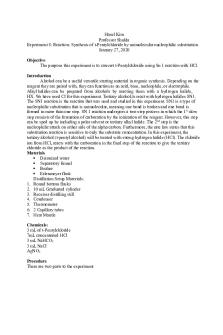Nucleophilic Substitutions PDF

| Title | Nucleophilic Substitutions |
|---|---|
| Author | Clarisbel Hernandez |
| Course | Organic Chemistry |
| Institution | Florida International University |
| Pages | 13 |
| File Size | 387.7 KB |
| File Type | |
| Total Downloads | 42 |
| Total Views | 132 |
Summary
Coursework...
Description
Lab #8: Nucleophilic Substitution Reactions: Mechanisms and Synthesis Clarisbel Hernandez Nova Yahaira Reyes October 22nd, 2020.
Purpose: The purpose of this experiment is to change 2-methyl-2-butanol to tert-amyl by the use of hydrochloric acid. Also, looking at SN1 and SN2 mechanisms compare the reactivity of alkyl halides.
Introduction: A nucleophilic substitution reaction can occur by two different mechanisms, SN1 or SN2. The SN1 mechanism is a unimolecular nucleophilic substitution, which requires the process to be completed in two steps. On the other
hand, the SN2 mechanism, is a bimolecular nucleophilic substitution, which only takes one step to complete. Deciding which mechanism will occur depends on the leaving group, nucleophile, and solvent. This experiment is divided into two parts, the first one is the preparation of tert-amyl chloride, and the second is the relative reactivity of alkyl halides. During the second part, the alkyl halides will be reacting with ethanolic silver nitrate, and NaI in acetone. T The alkyl halides that will be compared are t-butyl chloride, Allyl chloride, n-butyl bromide, n-butyl chloride, and sec-butyl chloride.
SN1 Reaction:
SN2 Reaction:
Procedures: Procedures were followed as stated in the lab manual
Table of Physical Constants:
Name
2-methyl-2-
Structure
MF
MW (g/mol)
D (g/
C5H12O
88.15
mL) 0.81
HCl
36.46
1.19
butanol Hydrochloric Acid
Tert-amyl
C5H11Cl
106.60
0.87
n-butyl chloride
C4H9Cl
92.57
-
Sec-butyl chloride
C4H9Cl
92.57
-
Chloride
t-butyl chloride
C4H9Cl
92.57
-
n-butyl bromide
C4H9Br
137.02
-
Allyl chloride
C3H5Cl
76.52
-
Results/ Data:
Part I: Synthesis: Preparation of tert-Amyl Chloride t-amyl alcohol mL added 12 mL grams 9.7 g moles 0.11 mol Moles of t-amyl chloride (1:1 ratio) 0.11 mol Grams of t-amyl chloride 11.75 g Limiting or excess reagent Limiting Theoretical yield 11.75 g Experimental grams of product 4.08 g Percent yield 34.72% Reaction:
Calculations: 12mL C5H12O x (0.81 g C5H12O/1 mL) = 9.72 g. C5H12O 9.72 g. C5H12O x (1 mol/ 88.15 g) =0.11 mol C5H12O M= mol/liters of solution 12M= mol/0.02L= 0.24 mol HCl 0.24 mol HCl x (36.46 g HCl/ 1 mol HCl) = 8.75 g HCl
HCl (12 M used) 20 mL 8.75 g 0.24 mol 0.24 mol 25.58 g Excess
12mL C5H12O x (0.81 g C5H12O/ 1 ml C5H12O) x (1 mol C5H12O/ 88.15 g C5H12O) x (1 mol C5H11 Cl/ 1 mol C5H12O) x (106.60 g C5H11 Cl/ 1 mol C5H11 Cl) = 11.75 g C5H11 Cl 0.24 mol HCl x (1 mol C5H11 Cl/ 1 mol HCl) x (106.60 g C5H11 Cl/ 1 mol C5H11 Cl) = 25.58 g C5H11 Cl P.Y= (Actual/ Theoretical)x 100%= (4.08/11.75)x 100%= 34.72%
Observations/notes: HCl was added to the alcohol in order to catalyze it.
Part II: Comparison of the Reactivity of Alkyl Halides
Part A: Alkyl Halides and SN1 Conditions- AgNO3/EtOH Reactions Time Alkyl Halide Structure 1o, 2o, 3o alkyl halide, precipitate or other formed
Observations
n-butyl chloride
1o
4
This was the slowest one, was expected not to react.
sec-butyl chloride
2o
5
Intermediate reaction time
t-butyl chloride
3o
1
Reacted quickly
n-butyl bromide
1o
3
This was the slowest one, was expected not to react.
Allyl chloride
Allyl halide, 1o
2
Reacted quickly
Ranking for SN1 Reactions from most reactive alkyl halide to least: t-butyl chloride, Allyl chloride, n-butyl bromide, n-butyl chloride, sec-butyl chloride. Reactions (if any):
Part B: Alkyl Halides and SN2 Conditions- Finkelstein NaI/acetone Reactions Time Observations Alkyl Halide Structure 1o, 2o, 3o
alkyl halide, or other
precipitate formed
n-butyl chloride
1o
3
Intermediate reaction time
sec-butyl chloride
2o
5
This was the slowest one to react
t-butyl chloride
3o
4
This was expected not to react, however reacted faster than secbutyl chloride.
n-butyl bromide
1o
2
Intermediate reaction time
Allyl chloride
Allyl halide, 1o
1
This one was the fastest to react
Ranking for SN2 Reactions from most reactive alkyl halide to least: Allyl Chloride, n-butyl bromide, n-butyl chloride, t-butyl chloride, and sec-butyl chloride.
Reactions (if any):...
Similar Free PDFs
Popular Institutions
- Tinajero National High School - Annex
- Politeknik Caltex Riau
- Yokohama City University
- SGT University
- University of Al-Qadisiyah
- Divine Word College of Vigan
- Techniek College Rotterdam
- Universidade de Santiago
- Universiti Teknologi MARA Cawangan Johor Kampus Pasir Gudang
- Poltekkes Kemenkes Yogyakarta
- Baguio City National High School
- Colegio san marcos
- preparatoria uno
- Centro de Bachillerato Tecnológico Industrial y de Servicios No. 107
- Dalian Maritime University
- Quang Trung Secondary School
- Colegio Tecnológico en Informática
- Corporación Regional de Educación Superior
- Grupo CEDVA
- Dar Al Uloom University
- Centro de Estudios Preuniversitarios de la Universidad Nacional de Ingeniería
- 上智大学
- Aakash International School, Nuna Majara
- San Felipe Neri Catholic School
- Kang Chiao International School - New Taipei City
- Misamis Occidental National High School
- Institución Educativa Escuela Normal Juan Ladrilleros
- Kolehiyo ng Pantukan
- Batanes State College
- Instituto Continental
- Sekolah Menengah Kejuruan Kesehatan Kaltara (Tarakan)
- Colegio de La Inmaculada Concepcion - Cebu















